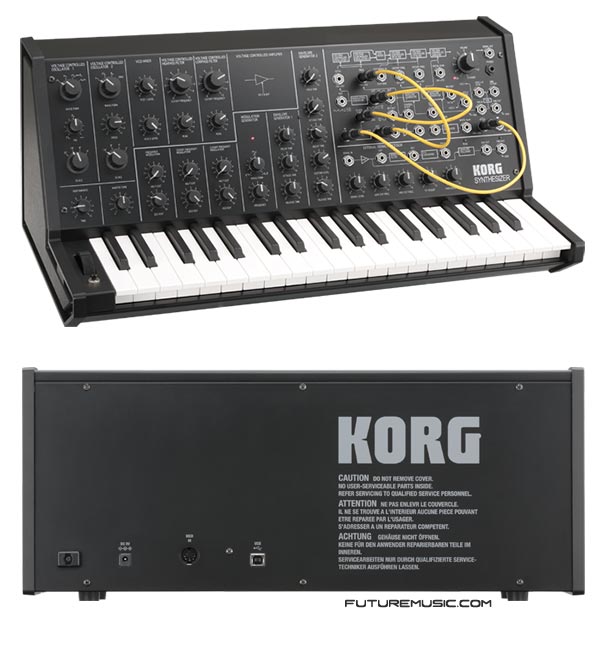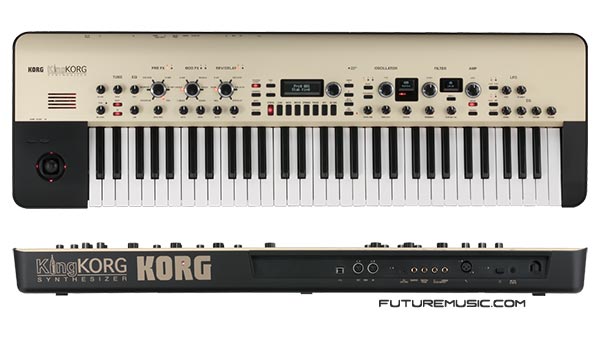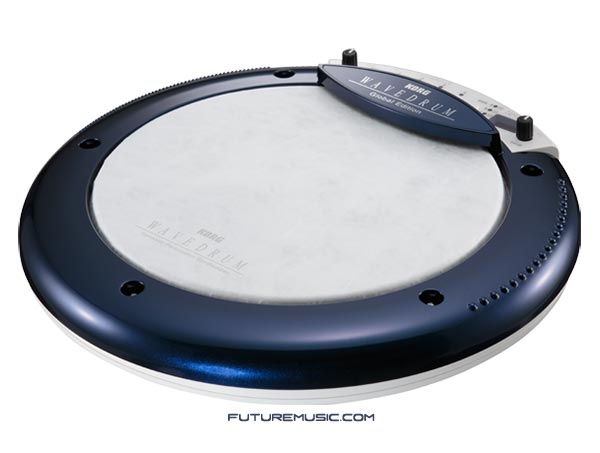Korg Is Back
By Greg Geller
After crapping their pants for a number of years, Korg has finally returned to what they do best, making great sounding gear that honors their legacy. After revealing the not-so-secret KingKorg performance virtual analog synth, the Japanese concern trotted out what had to be one of the most talked about bits of kit at the NAMM show, the MS-20 MINI.

Korg’s MS-20 monophonic synthesizer, first introduced in 1978, is a cultural and sonic icon. Units in good shape go for $1500 and up on the secondary market. The same engineers who developed the original MS-20 have perfectly reproduced its circuitry and fit into a body that’s been shrunk to 86% of the original size, yet retains the distinctive look of the original. (Imagine if Roland had the insight to reissue the TB-303 in 1994 with this thinking?? —Ed.)
Fifty years have passed since Korg was founded, and we have once again put our hand to an analog synthesizer. We took particular care to deliver smooth parameter adjustments, which are a distinctive feature of analog synthesizers. We also took special care to completely reproduce the original specifications of the MS-20. The analog circuits we designed 35 years ago still deliver the same unbeatable, powerful sound, from the ultra-low to the ultra-high range.
Features:
» Overseen by the engineers of the original MS-20, a complete replication of the original analog circuitry
» 2VCO / 2VCA / 2VCF / 2EG / 1LFO structure
» Self-oscillating high-pass/low-pass filters with distinctive distortion
» External signal processor (ESP)
» Flexible patching system
» 86% of the original size
» MIDI IN and USB connector
» Replicates every detail of the original, down to the package binding and the included manual
The MS-20 mini replicates the original MS-20. A development team led by the original engineers themselves worked to recreate the original circuitry, and when it was necessary to substitute a part, these engineers made the decisions based on careful listening, in order to reproduce the original sound faithfully. In fact, the sound of the MS-20 mini has a somewhat bright and extreme quality to it because its sound is that of an original MS-20 in mint condition at the time it went on sale, before any of the components aged.
The MS-20 mini reproduces the distinctive synthesis of the MS-20; two oscillators with ring modulation, and envelope generators with hold and delay. The VCA maintains the basic design of the original, but it’s been modified to produce less noise than the original. One of the known characteristics of the MS-20 was its powerful filters, which provided resonance on both the high-pass and the low-pass. Maximizing the resonance would cause the filter to self-oscillate like an oscillator, producing a distinctive and dramatic tonal change that was acclaimed as inimitable, and was later used on the monotron and monotribe. The filter circuit was changed mid-way through the production lifecycle of the MS-20; the MS-20 mini uses the earlier filter, which was felt to be superior due to its more radical sound.
![]()
![]()
The patching system provided to the right of the panel lets you create complex sounds by plugging-in cables to change the connections between the various units. The possibilities are limited only by the user’s imagination; different combinations of the modulation input/output and trigger, sample and hold, and noise generator can produce an incredible variety of sounds. By patching according to the MS-20 flow chart that’s printed on the panel, even the beginner can start taking advantage of these possibilities right away.
The ESP carries on the experimental spirit of MS-20; it allows you to use the pitch or volume of an external audio source to control the synthesizer. For example you can input an electric guitar and use the MS-20 mini as a guitar synthesizer, or input a mic and use it as a vocal synthesizer. The MS-20 mini provides a MIDI IN jack for receiving note messages, and a USB-MIDI connector that can transmit and receive note messages. You can even connect the MS20 mini to your computer and play it from a sequencer.
To make it even more approachable, the MS-20 mini has been shrunk to 86% of the size of the original MS-20. In spite of its smaller size, meticulous care has been taken to accurately reproduce the knob design and the printing. The patch cables have been changed from 1/4″ phone plugs to mini-plugs, and the newly-designed keyboard is also 86% of the original size. Our effort to remain faithful to the original is not limited to the unit itself. Even the package that contains the unit replicates the original as far as possible. Also included are the original MS-20 owner’s manual and settings chart, explaining how to create sounds. Now you can experience the excitement of the MS20, just like it was during its original release in 1978.
The Korg MS-20 MINI will sell for $599.
KingKorg
Korg says: “KingKORG is the full-fledged analog modeling synthesizer you’ve been waiting for.” Yeah, so why did it take you 10 years to actually give the people what they wanted??! It’s very difficult to understand the thinking behind certain gear companies and how they finally decide to debut products, but instead of pondering unanswerable questions, we’ll just tell you that Korg has done a commendable job with the KingKorg. No it’s not perfect, and haters will have plenty to b*tch about, but the KingKorg executes on many levels and has a pedigree that’s sounds like the offspring of Korg and Access. What I really liked was that it didn’t cave to the Dubstep craze with a biting sound that will only end up on eBay for a fifth of its retail price in a couple of years. Now you can distort the heck out of it, if you want, but its real mojo is its versatility. Not only does it feature virtual analog action and meat’n’potatoes samples of organs and pianos, but it has some sound sculpting possibilities that are fun and satisfying to create.

It carries on the design philosophy of classic Korg analog synthesizers such as the MS-20 and the Mono/Poly, but also delivers the unique characteristics of a dedicated synthesizer, especially the fun of transforming the sound by tweaking an impressive array of knobs.
Features:
» A full-fledged, 61-key analog modeling synthesizer designed for live performance
» Powerful oscillators that are understandable to the beginner, yet satisfying for the expert
» Modeling filters that reproduce the sound of classic instruments
» Three master effect sections (each with six effect types) add the finishing touch to your sound
» Vacuum tube driver circuit adds rich overtones and powerful distortion
» New panel layout designed for intuitive operation
» CV/GATE OUT jack lets you control a Korg monotribe or MS-20
» Support for librarian software that lets you manage programs
KingKORG features a 3-oscillator x 2-timbre design allows you to generate rich, creamy sounds, plus a newly developed XMT modeling sound engine. XMT (Xpanded Modeling Technology) is proprietary Korg technology that was created in order to produce a broad range of sonic variations while keeping operation simple. In a conventional synthesizer, the sound-creating process requires you to adjust the oscillator settings one by one, making it difficult to see the overall picture. In contrast, KingKORG provides pre-set algorithms that contain combinations of various types and numbers of oscillators, letting you easily and quickly sculpt stage-ready sounds. The wide range of oscillator algorithms includes the choices you’d expect from an analog synthesizer–sawtooth wave, square wave, and noise–in addition to numerous PCM/DWGS algorithms, giving you plenty of scope choices for creating highly personal sounds.
While designing KingKORG, extreme attention was paid to the filter section, which is crucial to a synthesizer’s character. A diverse variety of filters is a unique advantage of analog modeling, and KingKORG’s filters add unparalleled flexibility. In addition to a variety of essential analog modeling filter types, you get faithful models of filters that reproduce the analog monophonic synths used for lead and bass in the ’70s, the polyphonic synths used in new wave music of the ’80s, and the filters of Korg’s classic MS-20 analog synth. These filters can also be made to self-oscillate by raising the resonance setting– a unique capability of analog synthesizers.
![]()
![]()
KingKORG provides three master effect sections, each giving you a choice of six effect types: PRE FX, with types such as distortion and amp simulator; MOD FX, with classic effects like phaser, chorus, and tremolo; and REV/DELAY, with ambience effects such as hall reverb and modulation delay. Each effect processor has a dedicated front panel dial that selects the effect type. To choose the ideal effect type, simply turn the dial to hear the result, and use the FX control knobs located below these dials to adjust the effect as desired.
The built-in vocoder uses audio from the onboard mic input to modify the sound, creating an effect as though the synthesizer were talking. The vocoder features Formant Shift to dramatically modify the tonal character, as well as Formant Hold, which allows you to “freeze” a vowel sound and play it back using the keys. Thanks to the KingKORG’s dual-timbre architecture, you can even combine the vocoder with another timbre, either as a complementing sound or a modulation source.
On many classic synthesizers (such as the MS-20), the signal flow could be reconfigured using patch cables to physically connect one element to another. KingKORG reproduces this function with an intuitive Virtual Patch system. With six Virtual Patch assignments per timbre, control signals such as EG, LFO, or joystick movement can be virtually connected to sound parameters such as pitch or cutoff, allowing you to modulate a parameter for even greater sound-shaping possibilities.
The step arpeggiator automatically generates an arpeggiated phrase (broken chord) according to the chord you hold on the keyboard. You can choose from six arpeggio types, and specify the duration, interval, and on/off status of each step to enjoy a wide variety of performance possibilities.
What I didn’t necessarily like was the vacuum tube driver circuit that Korg applied as a “mastering effect” on the main outs. Korg claims that “You can use it to add warm fullness, a powerful overdrive, or anything in between.” However, I just found it muddied the sound and added noise. Maybe I’m completely tainted over the “Lipstick on a pig” addition of the tube on the Electribes, but even in the KingKorg, it just feels gimmicky.
Korg KingKorg: $1299
Kaoss & WaveDrum
Korg also dolled up the Kaossilator Pro and KP3 by adding some new sounds and effects to denote a new “+” in the name, but nothing that warrants much more than this sole sentence. They also came out with a new version of the WaveDrum, dubbed Global, that promises: “…the largest palette of cutting-edge sounds of any Wavedrum to date; with sought-after percussion sounds from around the world, a major boost in the quality of each sound, and dramatic improvements in usability.” I didn’t get to play it, but it should fall in line with the rest of the WaveDrum family quite nicely. At $600, I still think it’s a little too expensive for the intended market.

Korg WaveDrum Global: $599; Korg Kaossilator Pro+: $399; Korg KP3+: $349.








